-
Paper Information
- Previous Paper
- Paper Submission
-
Journal Information
- About This Journal
- Editorial Board
- Current Issue
- Archive
- Author Guidelines
- Contact Us
American Journal of Medicine and Medical Sciences
p-ISSN: 2165-901X e-ISSN: 2165-9036
2025; 15(3): 849-852
doi:10.5923/j.ajmms.20251503.76
Received: Feb. 11, 2025; Accepted: Mar. 25, 2025; Published: Mar. 31, 2025

Pathogenetic Basis of Labor Disorders in Severe Iron Deficiency Anemia
Karabayeva Marzhona Aminzhonovna, Khudoyarova Dildora Rahimovna, Karabaev Aminjon Gadaevich
Samarkand State Medical University, Samarkand, Republic of Uzbekistan
Copyright © 2025 The Author(s). Published by Scientific & Academic Publishing.
This work is licensed under the Creative Commons Attribution International License (CC BY).
http://creativecommons.org/licenses/by/4.0/

In severe iron deficiency anemia, depending on the body’s reactivity, a decrease in heart rate variability is observed against the background of a decrease in the triangular index, parasympathetic, and humoral components. Spectral analysis of an increase in the sympathetic component with centralization of regulation revealed a shift in adaptive reactivity towards unsatisfactory adaptation and maladaptation. Accordingly, there is an increase in pro-oxidant activity and endogenous intoxication, and a decrease in protein stability. Against the background of this type of reactivity, a decrease in the duration of pregnancy, an acceleration of the first and second periods of labor, a decrease in fetal weight, an increase in the mass of the placenta and an increase in the duration of the third period of labor were revealed in maternity patients. In the postpartum period, there was a lag in uterine invasion and hematometry, as well as an increase in the number of Caesarean section operations.
Keywords: Iron-deficiency anemia, Heart rate variability, Childbirth, Adaptation, Placenta, Fetus, Pro-oxidant, Antioxidant, Protein stability coefficient
Cite this paper: Karabayeva Marzhona Aminzhonovna, Khudoyarova Dildora Rahimovna, Karabaev Aminjon Gadaevich, Pathogenetic Basis of Labor Disorders in Severe Iron Deficiency Anemia, American Journal of Medicine and Medical Sciences, Vol. 15 No. 3, 2025, pp. 849-852. doi: 10.5923/j.ajmms.20251503.76.
Article Outline
1. Introduction
- Currently, the number of pregnant women with iron deficiency anemia of various etiologies occupies one of the leading places in the world. According to WHO, this pathology affects about 2 billion people on earth, which corresponds to 30% of the total population. At the same time, among pregnant women, hemoglobin levels range from 21 to 80%, and serum iron levels range from 49 to 99% [11]. Iron deficiency anemia underlies the disruption of redox processes in the body of pregnant women, which is against the background of a lack of divalent iron (Fe++) in the body of pregnant women in the composition of hemoglobin, myoglobin, respiratory chain of cells in the NAD, FAD, cytochrome a, b, c, impairs the transport of oxygen, carbon dioxide, and electrons [1,2]. Metabolic acidosis can develop in pregnant women due to this impaired oxygen and carbon dioxide is disrupted [7,9]. Which in turn promotes the expression of chemoreceptors and glomus receptors at the base of the aortic arch and carotid sinus, as well as the medulla oblongata [3]. The expression of receptors primarily promotes the activation of the sympathoadrenal system in pregnant women [13]. Activation of the sympathoadrenal system in a cascade mode promotes the release of hormones from the hypothalamus, adrenal glands, and pancreas and ensures the development of adaptation to this kind of hypoxia [15]. Against the background of this kind of activation of ergotropic systems at the mitochondrial level, an increase in oxidative processes for the combustion of plastic materials and overload hypoxia are ensured [16]. In the respiratory chain, activation of the pro-oxidant system occurs against the background of overloading hypoxia, and lack of activity of the antioxidant system contributes to the formation of atomic oxygen (O), hydrogen peroxide (H2O2), and hydroxide (OH) [19,16]. These compounds act on the structural components of the body's cells and contribute to their destruction [5,8]. In this regard, the study of the pathogenetic foundations of women's labor disorders in severe iron deficiency anemia remains an urgent problem, since reactivity and adaptive capabilities to pregnancy and labor are sharply disrupted against the background of such changes in the mother's body.This, in turn, can lead to irreversible complications.The purpose of the study: to identify the mechanisms of labor disorders in severe iron deficiency anemia.The research objective:1. To study the adaptive capabilities of maternity hospitals with severe iron deficiency anemia.2. To study the pro-oxidant, antioxidant activity and indicators of endogenous intoxication of maternity women with severe iron deficiency anemia.3. To study the periods of labor and uterine invasion in the postpartum period with severe iron deficiency anemia.
2. Materials and Methods of Research
- We studied 30 maternity hospitals with normochromic type of blood supply and 30 with severe iron deficiency anemia. The reactivity of the maternity hospital was determined using the Neurolab-Biomysh device. The pro-oxidant activity was studied by malondialdehyde (MDA) [18]. Antioxidant activity was determined by the catalase index [10]. The indicators of endogenous intoxication and the coefficient of protein stability were also studied using the Gabrielyan method [6].
3. The Obtained Results and Their Discussion
- When studying the reactivity of the women’s body of women in labor with severe iron deficiency anemia, 5 (16%) women revealed normoadaptive reactivity with a shift towards the voltage of regulatory systems, that is, while the heart rate variability in spectral analysis revealed the preservation of the HF parasympathetic component within the normal range, and the VLF component of humoral regulation was reduced. At the same time, an increase in the LF-sympathetic component with centralization of regulation was revealed in comparison with the data of maternity hospitals with a normochromic type of blood supply (Image 1 and 2).
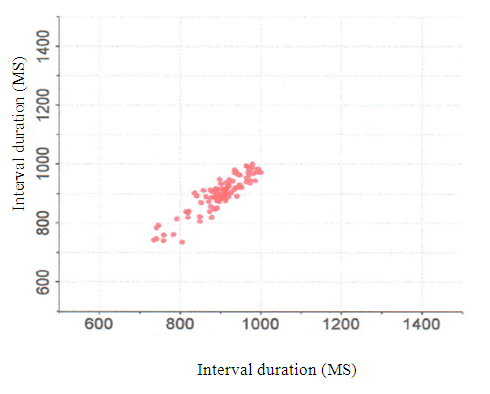 | Image 1. The scatterogram |
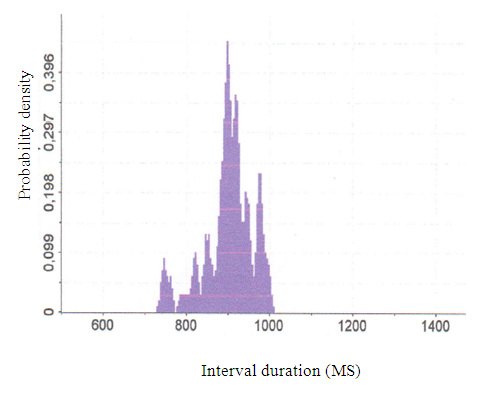 | Image 2. Probability density |
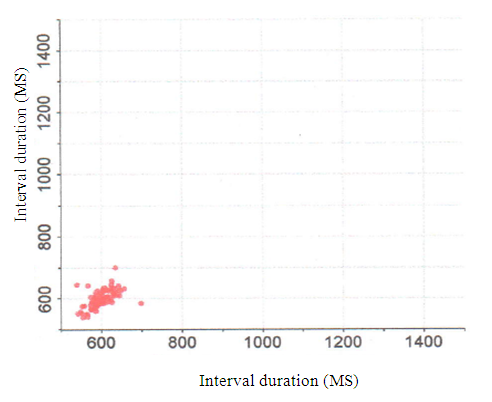 | Image 3. The scatterogram |
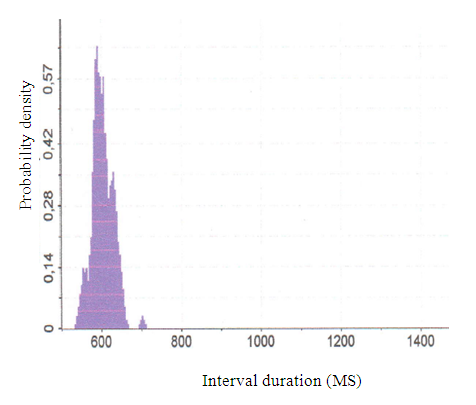 | Image 4. Probability density |
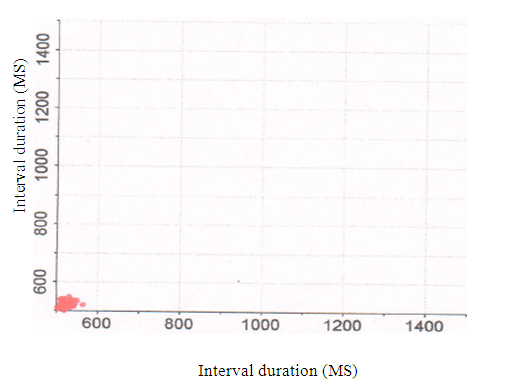 | Image 5. The scatterogram |
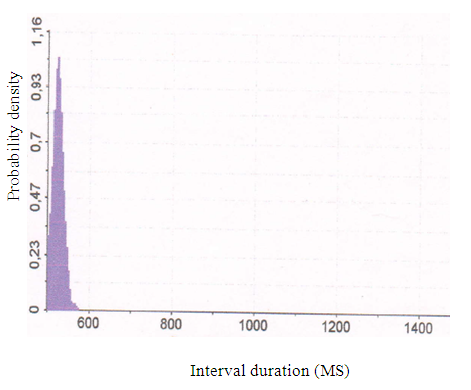 | Image 6. Probability density |
4. Conclusions
- 1. In severe iron deficiency anemia, depending on the reactivity of the body, a decrease in heart rate variability is observed, against the background of a decrease in the triangular index, parasympathetic, and humoral components, an increase in the sympathetic component with centralization of regulation revealed a shift in adaptive reactivity towards unsatisfactory adaptation and de-adaptation. 2. Accordingly, an increase in sympathetic reactivity, an increase in pro-oxidant activity and endogenous intaxification, a decrease in protein stability reveals a decrease in the duration of pregnancy, acceleration of the first and second periods of labor, a decrease in fetal weight, an increase in placental mass, the duration of the third period of labor, a lag in uterine involution in the postpartum period and hematometry.3. As the triangular index and the functional state index decrease, the maladaptive reaction in the mother's body and the rate of caesarean sections increase.
 Abstract
Abstract Reference
Reference Full-Text PDF
Full-Text PDF Full-text HTML
Full-text HTML